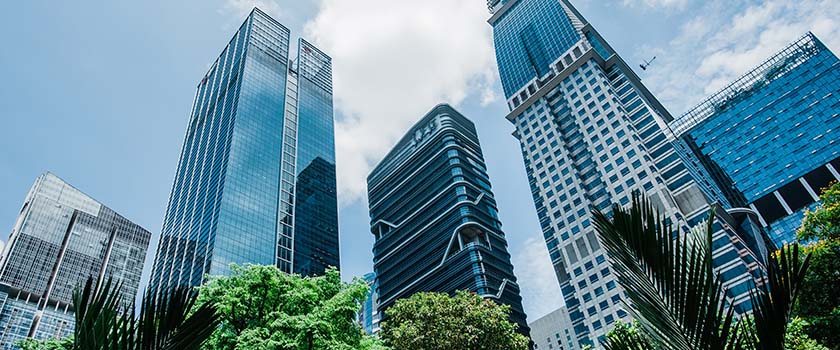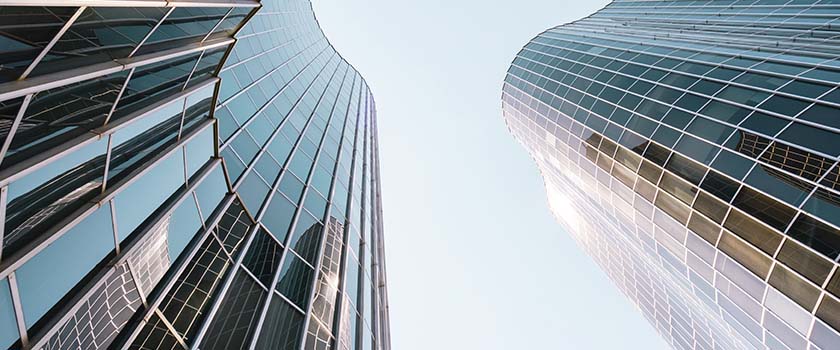Shanghai has entered its fourth week under lockdown, as authorities aim to clamp down on an outbreak of the omicron BA.2 variant. Other cities have also been impacted, with these areas accounting for 17% of China’s GDP.
Key takeaways
- Although Q1-22 figures were stronger than expected at 4.8% y/y, we expect that lockdown measures will drag significantly on Q2-22 growth. Domestic consumption will lead to declines, after contracting -3.5% y/y in March.
- Our 2022 GDP forecast of 5.0% could still be achieved in case we see a rebound in consumption after June, especially given a slightly easier stance from PBOC and lower mortgage rates. However, the worst months are still ahead of us.
- The markets have not priced in the impact of weaker activity in Q2-22. We expect additional pressure on total equity returns, higher credit stress and CNY depreciation, before stimulus leads to recovery towards H2-22.
Extended lockdown to dampen economic activity
On March 27, Chinese authorities ordered a citywide lockdown in Shanghai. The lockdown was originally intended to take place in two phases, lasting eight days. However, things did not pan out this way. On April 9, the central government took over from local authorities, imposing stricter measures. The approach is based on previous successes in Wuhan, Xi’an, and Shenzhen, where lockdowns were able to curb the spread of the virus within several weeks. However, it’s unclear if this will work in Shanghai, given the city’s vast population of 26 million and more contagious omicron BA.2 variant. Shanghai has now officially entered its fourth week under lockdown, but the infection rate has not declined meaningfully. On April 18, the city reported 31,403 new infections. Some factories and other companies have started to resume operations under the new “closed loop” system, where the workforce lives and works on the company’s premises. To make matters worse, many residents were not adequately prepared for an extended lockdown, resulting in rare reports of food shortages. This led to food stockpiling behaviours across the country. For example, mandatory testing orders in Guangzhou, in early April, led residents to rush to stockpile food ahead of an expected lockdown.
Such trends will likely exacerbate inflationary pressures. The Consumer Price Index (CPI) remained subdued in March, expanding 1.5% y/y, but the devil is in the detail. Most of this downside pressure can be traced back to pork prices, which declined by -41.4% y/y. Vegetable prices, on the other hand, surged 17.2% y/y. Rising energy prices will also play a role in driving higher inflation. Although most downstream prices are regulated in China, we have started to see upstream companies passing through higher energy costs. For instance, gasoline prices surged 24.6% y/y in March while LPG increased 27.1% y/y. At the National People’s Congress, Premier Li Keqiang set a target for CPI growth this year to be around 3.0% y/y. We expect that this level could be exceeded over the summer months, as a normalisation in pork supply chain and higher energy costs could result in a CPI overshoot of around 4.5% y/y, before cooling to 3.0% y/y by the end of the year.
GDP growth was stronger than expected in Q1-22, coming in at 4.8% y/y compared to 4.0% in Q4-22 and led by a 6.0% y/y increase in the secondary sector. However, these figures don’t yet reflect the impact of Shanghai’s lockdown, which only started in April. The combination of extended lockdowns and rising inflation will significantly dampen economic activity in the second quarter of 2022 (Q2-22). The main channel will be domestic consumption. The cities that are currently impacted by full lockdowns account for 17% of China’s GDP. However, their share in national consumption is likely much higher, as they are the main consumption centres. We already got a glimpse of this in March, with retail sales contracting by -3.5% y/y, the first negative data print since July 2020. We expect to see an even sharper contraction in April and May.
Industrial production remained supported at 5.0% y/y, down from 7.5% in January-February. This reflects two factors. Firstly, manufacturing activity benefited from strong external demand, with exports growing almost 15% y/y despite disruptions to shipments via Shenzhen. In second place, key sectors may have ramped up production ahead of expected supply chain disruptions. For example, new energy vehicles were up 140.8% y/y, solar cells 24.3% and industrial robots 10.2%. These factors should cool in the coming months. Fixed Asset Investment (FAI) continued to underpin growth, expanding by 9.3% YTD y/y in March and led by an 11.7% YTD y/y increase in public sector FAI. However, we also expect these to cool in coming months, as increasingly more people enter government isolation facilities, leading to labour shortages.
Three factors that may be holding back the PBOC
On March 16, Vice Premier Liu He announced that the State Council would roll out measures to bolster capital markets and stabilise economic growth. Since March 16, Premier Li Keqiang has issued three warnings about economic growth. On April 11, he stated that a “sense of urgency” was needed in implementing policy, adding that pro-growth policies to support the economy should be brought forward, including tax cuts, issuance of special bonds, and incentives to support the labour market and SMEs.
Notwithstanding this encouraging rhetoric, the People’s Bank of China (PBOC) has not yet delivered resolute support. On April 20, the PBOC opted to keep its Loan Prime Rate (LPR) unchanged at 3.70% for a third consecutive month. This followed a modest 25 basis point (bp) cut to the Reserve Requirement Ratio (RRR), missing expectations of a 50-100 bp cut. In line with this more “targeted” approach, the PBOC also announced an additional 25bps reduction for some smaller City Commercial Banks (CCB) and rural commercial banks. CCBs have more exposure to mortgages and therefore will be instrumental in stabilising the housing sector. All in all, the PBOC said the new RRR cuts will release about 530 billion yuan (USD 83.2bn) in long-term liquidity.
There are three main factors that may be holding the PBOC back from delivering stronger policy accommodation:
- Risk of outflows: The PBOC may be concerned about a widening policy differential between China and the US. The premium of China’s 10-year government bond yield over that of the US vanished in April. The risk-reward balance thus tilts in favour of US bonds, resulting in outflows from Chinese asset classes. The real rate differential remains positive around 3.8%, but policy accommodation could fuel inflationary risks and stoke depreciatory pressures.
- Timing is everything: Admittedly, trimming interest rates while the lockdowns remain in place will do little to boost real activity. An increasingly larger number of workers are entering government isolation facilities, resulting in labour shortages and disruptions to operations. That makes it harder for companies to invest and for households to consume. It’s possible that the PBOC is waiting until the situation is more under control to re-examine its policy options.
- Stronger Q1 buys them time: Activity came in stronger than expected in Q1-22, owing to strong performance during January-February. Therefore, the PBOC may be comfortable letting activity decline slightly in Q2-22, before considering how much additional liquidity is needed to spur recovery in H2-22.
The PBOC pledged to use an “arsenal” of tools to address headwinds in 2022. Banks have cut mortgage rates by 20- 60 bp in more than 100 cities in April, in a bid to boost the real estate sector. Together with the modest RRR cut on April 19, these measures nudged interbank rates 0.5 bp lower in April. Going forward, we think that the PBOC will deploy monetary aggregates more aggressively. M2 growth is expected to increase from 9.7% y/y in March to 10.0% on average in 2022, while outstanding total social financing will increase from 10.6% y/y in March to 12.0% on average in 2022. We can’t exclude the possibility of an additional 25- 75 bp in RRR cuts in 2022. However, the window for another 10 bp rate cut is narrowing as inflation rises.
Implications for investors: GDP growth and markets
The main implication for investors will be understanding what this means in terms of real activity. The International Monetary Fund (IMF) cut its global GDP growth projection to 3.6% during its April World Economic Outlook. Under the IMF’s new scenario, Chinese GDP will expand 4.4% in 2022, significantly below the official 5.5% target. Although we expect to see downside risks to the consensus in the coming weeks, the scenario described by the IMF remains unlikely during a politically sensitive year. Moreover, China only narrowly missed its GDP growth target twice by 0.1% in 2014 and 2015. Such a large departure is unprecedented and constitutes a significant break with convention.
Under our baseline scenario, 5.0% could still be achieved in case we see a rebound in consumption after June, especially given a slightly easier stance from PBOC and lower mortgage rates. Although we have not changed our forecast, the worst months are still ahead of us. Investor sentiment will remain extremely fragile during this period. The weakest “quarter” of growth has shifted from January- March to March-May. We have therefore downgraded our growth projections for Q2-22 to 3.5% y/y, down from 4.5% (consensus: 4.6%). Our 2022 forecast of 5.0% considers stronger performance in Q1-22 and assumes a recovery rate of 5.5% y/y on average in H2-22. However, we acknowledge that risks are tilted to the downside. In case lockdowns extend into Q3-22, GDP growth could undershoot our forecast by 0.2-0.3% (4.7-4.8%).
Against this backdrop, we believe that markets may not have priced in the impact of weaker activity in the months ahead. Chinese equities experienced a sharp compression in multiples during 2021 and 2022. However, earnings growth expectations remain sanguine at 11.43%. We expect that downward revisions to earnings will continue to drive the derating in the short term. Global investors should remain focused on de-risking portfolios until a new equilibrium is reached, or additional PBOC stimulus becomes effective, most likely towards the end of H2-22. Credit investors should also remain cautious. Policy tapering in the US tends to result in a widening of both Investment Grade (IG) and High Yield (HY) credit spreads, suggesting that a more defensive stance with regards to Asian credits is likely warranted at this stage.








